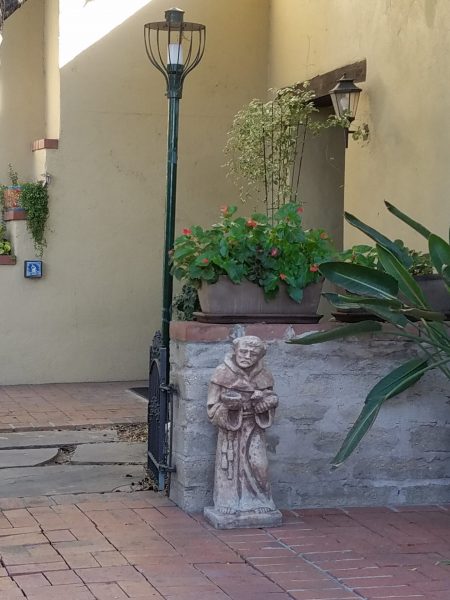The Spiritual Exercises
About the Spiritual Exercises
The Spiritual Exercises are the foundation of Ignatian Spirituality and the worldwide mission of the Jesuit Order of priests. The Exercises emerge from the life experiences of Iñigo Loyola (1491–1556), a brash, prestige-seeking Basque nobleman and soldier who was converted to an intense Christian faith while recovering from battle wounds. During his convalescence, he read books about the life of Christ and heroes of the faith and realized that his passionate pursuit of worldly renown would be better-aimed if harnessed in the service of Christ. After many years of prayer, self-reflection, discernment, and giving spiritual direction to others— during which he changed his name to Ignatius and led the founding of the Jesuits — he compiled his insights into a handbook called the Spiritual Exercises. That handbook has served as an essential resource for spiritual directors to accompany those seeking a deep experience of the love of God for almost 500 years.
“Everyone should take the Spiritual Exercises. They arrived at a moment in my life when I was ready to deepen my faith in ways I don’t think I could have done on my own. While I was following the Exercises I felt like I was blessed with a great gift, one that continues to inspire me today. Tom Cashman was the spiritual director and guide I’d been seeking for many years.“
Chuck Appleby – California

Ignatian Spirituality
Ignatian spirituality asserts that God is present “in all things” and that God “labors on our behalf” to draw us close to him. Jesuit educator and author Kevin O'Brien SJ, says that in the Exercises, “Ignatius invites us into an intimate encounter with God revealed in Jesus Christ so that we can think and act more like Christ.”

Increasing Openness To The Movement Of The Spirit
In the words of Ignatius as translated by David Fleming SJ, the Spiritual Exercises “are good for increasing openness to the movement of the Spirit, for helping to bring to light the darkness of sinfulness and sinful tendencies within ourselves, and for strengthening and supporting us in the effort to respond more faithfully to the love of God.” Ignatian Spirituality affirms that God is present in all things — in creation, in our relationships, our jobs, our thoughts, in our culture – and in all we do.

What is the 19th Annotation?
The Spiritual Exercises were initially intended to be given by a spiritual director and made by a retreatant in a thirty-day silent retreat of daily prayer and daily conferences with the director. The retreatant would leave her or his home and everyday demands and responsibilities and go to a retreat center or monastery to make the Exercises. One can do this today at scores of outstanding Jesuit retreat centers around the world. Ignatius soon realized that many who desired to make the Exercises were not in circumstances that allowed them to leave their homes, families, and responsibilities for a month or more. He developed the 19th Annotation, an adaptation to the Exercises , to make it possible to complete the full Spiritual Exercises in 32-36 weeks.

Waypoints Spiritual Direction uses the 19th Annotation as its retreat model.
Instead of leaving one’s daily routine, today a retreatant can complete the retreat through a disciplined habit of prayer and exercises of forty-five minutes to an hour each day. One of the gifts of the 19th Annotation is that a retreatant can integrate the blessings of the Exercises into the circumstances of their family and professional life through a consistent habit of daily prayer, contemplation, and discernment that will last a lifetime.

Ignatius required retreatants to take the Exercises with the encouragement of a qualified spiritual director. An Ignatian spiritual director is a faithful Christian who feels called to be a companion on another’s faith journey. The director has completed formal training to give the Exercises before being credentialed to guide others and has been directed in the practice of daily prayer with scripture for at least two to three years.
Ignatian Spirituality believes there are three participants engaged in the Exercises: God, who initiates and leads the relationship; the retreatant; and the spiritual director. The retreatant and director meet at weekly meetings called conferences. The director provides the retreatant with assigned scripture readings, questions, and prayer exercises to do between their conferences. These exercises follow the order prescribed by St Ignatius and are customized to the needs and pace of the retreatant’s journey through the Exercises. In each conference session, the retreatant shares with the director their experiences engaging in prayer and with the readings. By listening closely, the director helps the retreatant identify those movements of God that invite him or her to draw closer to God. The director also helps the retreatant discern those movements — distractions, temptations, sins, unhealthy attachments, and ego-centered preferences — that entice them away from God.
At the conclusion of each conference, the director will give the retreatant a new set of exercises with questions and concrete topics for the retreatant to think and pray about between their conference sessions.
Conference sessions at Waypoints Spiritual Direction are held online via digital video conference applications.
The relationship of the retreatant and the director is one of trust and friendship in God. The director is not the retreatant’s confessor. But the director will help the retreatant respond to God’s invitation to deal with their sin and may advise the retreatant to go to confession.
The director does not impose his or her spiritual or religious agenda on the retreatant. Nor does the director provide advice that addresses those challenges faced in daily life, career, or family that require the services of a licensed psychologist, mental health professional, or counselor.
The Structure of the Spiritual Exercises
The Spiritual Exercises follow closely the key events in the life and ministry of Jesus and the liturgical calendar of the Church year. For those beginning the Exercises in September, the Nativity of the Lord is typically contemplated during the Advent and Christmas seasons; the accounts of Jesus’ preaching, teaching, and healing are contemplated from January to March; and Jesus’ Passion, Resurrection, and Ascension are contemplated from Lent to Pentecost.
By engaging with scripture and prayer, and with exercises of the imagination called meditations and contemplations, the Spiritual Exercises help the retreatant consider who they are for God and who God is for them.
The retreatant is not required to begin the Exercises in September. They can be arranged as it convenient for you.

The Preparation Days
Three to four weeks before the start of the formal Four Weeks of the Exercises are the Preparation Days when you and your director get to know one another, and when you establish disciplines you will use throughout the retreat. You will be introduced to the Principle and Foundation and the Examination of Conscience, known also as the Examen Prayer, that helps you begin to discern movements in your life. You will develop the discipline of learning to pray for a significant amount of time each day, for approximately 45 minutes to an hour.
The Four Weeks
The Exercises are divided into four sections called Weeks. The Weeks do not correspond to a seven-day calendar week. The Weeks organize distinct themes of prayers, contemplations, and meditations for the retreatant to learn to experience God’s nearness and God’s graces:
First Week
During the First Week, we reflect on our lives in light of God’s boundless love for us. We focus on who God is and how our response to God’s love has been stalled or diverted by patterns of sin. We consider our sin knowing that God wants to free us from our disordered affections — those attitudes, actions, and possessions that prevent us from committing ourselves fully to God’s service. The First Week ends with a meditation on committing ourselves to Jesus’ call to follow him.
Second Week
With meditations and prayers with scripture about Jesus’ birth and baptism, the Sermon on the Mount, and his teachings and healings, we learn what it means to follow Jesus as one of his disciples. In our prayers, we ask for an intimate knowledge of Jesus to see him more clearly, love him more dearly, and follow him more nearly.
Third Week
We meditate on the Last Supper, on Christ’s passion and death, and the Eucharist, and see in his suffering the full expression of God’s love for us.
Fourth Week
We meditate on Jesus’ resurrection and his appearances to his disciples. We walk with the risen Christ and set out to love and serve him in concrete ways in our lives and in the world. In the Fourth Week, we are asked to make a decision: to change our lives to commit ourselves to do Christ’s work in the world.

Prayer in the Exercises
The Spiritual Exercises teach us how to be in close relationship to God who desires intimacy with us.
We know that for a relationship to be successful, both parties need to know how to listen to one another. Both must give and take; speak and listen. Many of us first learned to pray in one direction only: we may tell God all of our needs (which he knows of already) and then end our prayer likely expecting God to respond in full and form to our request. For us to understand more of what God wants for us, we must learn to wait upon God by listening and watching for God’s initiative and response to our prayer.
The Spiritual Exercises present three methods of prayer that may be new to retreatants — meditation and contemplation. Kevin O’Brien SJ succinctly defines meditation and contemplation in his book, The Ignatian Adventure:
In meditation, we use our intellect to wrestle with basic principles that guide our life. Reading scripture, we pray over words, images, and ideas. We engage our memory to appreciate the activity of God in our life. Such insights into who God is and who we are before God allow our hearts to be moved.
Contemplation is more about feeling than thinking. Contemplation often stirs the emotions and enkindles deep desires. In contemplation, we rely on our imagination to place ourselves in a setting from the Gospels or in a scene proposed by Ignatius. . . In the Exercises, we pray with Scripture; we do not study it.
Application of the Senses is a third type of prayer used throughout the Exercises, which John J.English SJ, describes as “a method of contemplating with our whole being.” Where, with contemplation we use our intellect to deeply consider the scriptural truths, and with meditation we engage our hearts and emotions, with application of the senses “the totality of our being becomes involved.” We use our imaginations to see, hear, smell, touch and sense the presence of the scripture scene we are praying.

Discernment of Spirits
As our intimacy with God grows, we become more aware of interior movements that influence our lives. Ignatius called these movements “motions of the soul.” They include emotions, feelings, desires and inclinations, attitudes and actions, attractions, and revulsions. Sometimes we sense them coming from within us. At other times they seem to arrive from outside us. Discernment of spirits involves becoming sensitive to these movements, recognizing them and understanding their source, and where they lead us.
The website ignatianspirituality.com explains these well:
Ignatius believed that these interior movements were caused by “good spirits” and “evil spirits.” We want to follow the action of a good spirit and reject the action of an evil spirit. Discernment of spirits is a way to understand God’s will or desire for us in our life.
“Talk of good and evil spirits may seem foreign to us. Psychology gives us other names for what Ignatius called good and evil spirits. Yet Ignatius’s language is useful because it recognizes the reality of evil. Evil is both greater than we are and part of who we are. Our hearts are divided between good and evil impulses. To call these “spirits” simply recognizes the spiritual dimension of this inner struggle.”
Consolation and Desolation
In Ignatian Spirituality, feelings stirred up by good and evil spirits are called consolation and desolation.
Spiritual consolation is an experience of being so on fire with God’s love that we feel compelled to praise, love, and serve God and help others as best as we can. Spiritual consolation encourages and facilitates a deep sense of gratitude for God’s faithfulness, mercy, and companionship in our life. In consolation, we feel more alive and connected to others.
Spiritual desolation, by contrast, is an experience of the soul in heavy darkness or turmoil. We are assaulted by all sorts of doubts, bombarded by temptations, and mired in self-preoccupations. We are excessively restless and anxious and feel cut off from others. Such feelings, in Ignatius’s words, “move one toward lack of faith and leave one without hope and without love.”
The key question in interpreting consolation and desolation is: where is the movement coming from and where is it leading me? Spiritual consolation does not always mean happiness. Spiritual desolation does not always mean sadness. Sometimes an experience of sadness is a moment of conversion and intimacy with God. Times of human suffering can be moments of great grace. Similarly, peace or happiness can be illusory if these feelings are helping us avoid changes we need to make.


